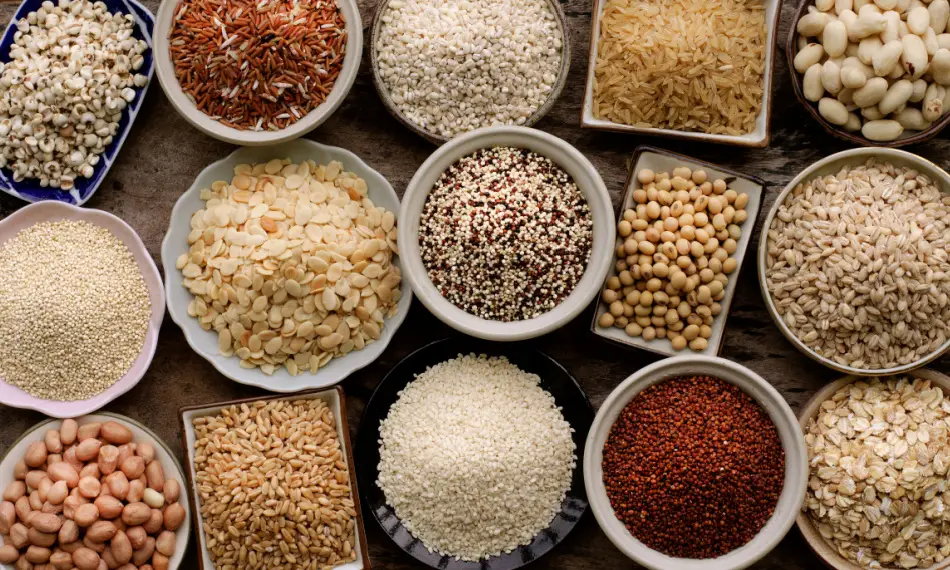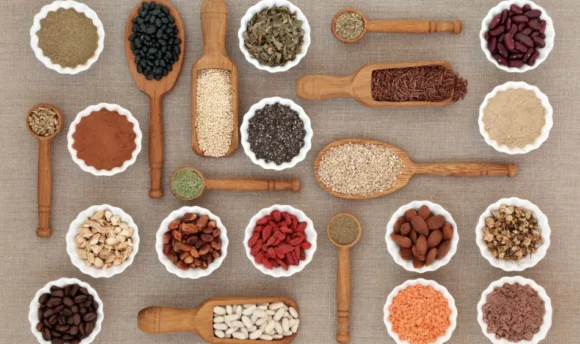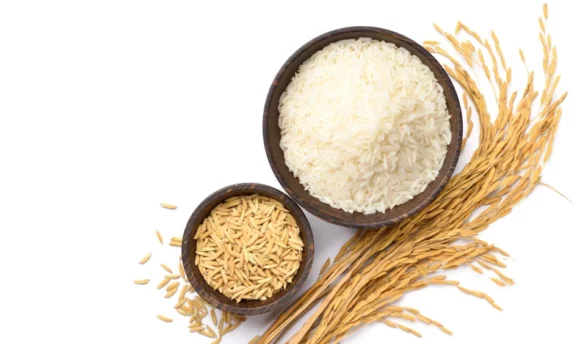10 Best Low-Calorie Grains to Add to Your Grocery List
Elevate your meals with nature’s hearty staples

A common misconception about eating healthily is that you must completely cut out carbs from your diet. However, carbohydrates are the body’s main energy source and make up an essential part of any balanced weight loss diet.
Grains are a type of carbohydrate that, contrary to popular belief, can help you lose weight when consumed correctly. Many grain varieties are low in calories yet high in fiber and protein, two nutrients that contribute to feelings of fullness and offer many other important health benefits.
But how do you know which grains for weight loss to choose, particularly if you’re trying to watch your calorie consumption? We’ll explain the top 10 grains you should add to your meals and why they may benefit your daily diet.
What Are Low-Calorie Grains?
As a staple food worldwide, grains are edible seeds originating from grass-like plants called cereals. From bread and crackers to flour and rice, they come in various forms, with some types having a higher calorie content than others, making them less suitable when losing weight.
Low-calorie grains are those that haven’t gone through the process of being ground down into flour. Grains that have gone through a grinding process tend to be more calorie-dense, higher in sugars and saturated fats, and lower in nutrients, including breads, bagels, chips, and crackers.
It’s also much easier to eat more of these high-calorie grains in one sitting. For instance, you’re more likely to be able to eat 5 slices of bread in comparison to 5 bowls of whole-grain oatmeal, which can be detrimental if you’re trying to lose weight.
Eating smaller portions of lower-calorie grains can, therefore, help you to feel satiated without consuming too much food. This makes it easier to stick to a calorie deficit, where you take in fewer calories than your body burns, which is essential for losing weight.
You should also try to eat mainly whole grains, which have the bran, germ, and endosperm parts intact. In contrast, refined grains contain only the starchy endosperm and are stripped of essential vitamins, minerals, and antioxidants. They are also lower in fiber, a nutrient that keeps you full, maintains a healthy heart, and keeps your digestive system running smoothly.
Top Low-Calorie Grains to Include in Your Diet
Wondering which grains make great weight-loss foods? Whether you’re hoping to drop a few pounds or simply stay healthy, here are the top 10 whole grains to consider adding to your plate when trying to lose weight:
#1 Whole Rye
Calories per 100 grams: 338
Sometimes referred to as rye berries, whole rye kernels are typically used to produce flour. This can then be made into dark rye bread, which offers a stronger, earthier taste than regular whole wheat bread. Toast a slice and serve with avocado and eggs for a healthy open sandwich.
With nearly 50% more fiber than whole wheat, whole rye is a great option for those hoping to maintain good digestive health. In particular, rye is high in soluble fiber, which slows digestion and causes a gradual rise in blood sugar levels to prevent hunger.
#2 Bulgur
Calories per 100 grams: 342
Made from cracked wheat berries, bulgur is an easy-to-prepare, versatile, and highly nutritious cereal grain. The nutty grain is low in calories yet high in protein and fiber, delivering 12.5 grams of the latter per 100 grams.
Along with this, bulgur is a great source of manganese, a trace mineral needed by your body in small amounts for maintaining good bone health and reducing inflammation. It is also a food high in magnesium, which is responsible for the action of over 300 enzymes in the body.
Bulgur wheat is typically used to create tabbouleh, a fresh and herby Middle Eastern salad that combines this healthy grain with parsley, mint, and lemon. It also makes a great lighter alternative to meat when made into a patty.
#3 Buckwheat
Calories per 100 grams: 356
Despite the name, buckwheat doesn’t actually contain wheat and is, therefore, a gluten-free grain. Like many of the other grains in our guide, it is an excellent source of plant-based protein, with over 11 grams per 100-gram serving.
Today, buckwheat grains, or groats as they are also known, are considered a superfood thanks to their high mineral content, including manganese, copper, and magnesium.
It also contains more antioxidants than other cereal grains like rye, wheat, and barley. This includes rutin, a polyphenol with antioxidant properties that can lower the risk of cancer, improve inflammation, and aid blood sugar management.
Use buckwheat flour to add a slightly nutty taste to traditional French crepes and fill with ham or cheese. Alternatively, buckwheat grains can be used as an oat alternative for a twist to traditional oatmeal or stuff them into peppers as a delicious side dish.
#4 Barley
Calories per 100 grams: 352
Packed full of phytonutrients, barley is another low-calorie whole-grain option to add to your diet. Although pearled barley is the most common type, its fibrous bran is removed, so choose the hulled variety for a higher fiber, more nutritious option.
Along with antioxidants like beta-carotene and vitamin E, hulled barley contains mainly beta-glucan. This type of soluble fiber contributes to lower cholesterol and better blood sugar levels.
When it comes to eating barley, the grain makes a hearty addition to soups and works as an interesting alternative to risotto rice.
#5 Lentils
Calories per 100 grams: 352
Like beans, chickpeas, and peanuts, lentils are technically a legume. However, they work as a great grain or meat substitute in many dishes, including curries, soups, salads, and even tacos.
Along with being low-calorie, lentils are a good plant-based source of protein, offering a huge 24.6 grams per 100 grams when raw. They also contain a range of essential minerals, including iron, which can be difficult to get through a vegan or vegetarian diet.
From red and green to Puy and beluga, lentils come in many different varieties. However, all types are packed full of polyphenols, plant chemicals that have antioxidant and anti-inflammatory effects.
#6 Brown Rice
Calories per 100 grams: 367
In terms of grains, brown rice is the best rice option for weight loss because it has the whole grain intact.
When compared to white rice, the brown variety contains much more fiber, at 3.6 grams versus 1.3 grams per 100-gram serving. It also has a low glycemic index (GI), meaning that it causes a gradual rise in blood sugar and therefore helps to control appetite.
Plus, brown rice is packed full of important vitamins, minerals, and antioxidants that fight free radicals, lowering your risk of chronic diseases such as type 2 diabetes and cancer.
#7 Quinoa
Calories per 100 grams: 368
As a superfood, quinoa is popular in many weight loss diets for its low-calorie content.
The crop is packed with 14.1 grams of complete, high-quality protein per 100-gram serving. This means it delivers all 9 essential amino acids you must get through your diet. Like lentils, it is also another food high in iron for those on a vegetarian or vegan diet.
Although not technically a grain, quinoa is consumed similarly to many of the other grains we’ve discussed. Pair it with salmon and roasted vegetables for a well-balanced meal, or cook with coconut milk and honey for a tasty dessert option.
#8 Amaranth
Calories per 100 grams: 371
Amaranth is an ancient grain that has recently started to gain popularity as a health food. As well as being low calorie, studies show that it may reduce inflammation, which can be caused by weight gain.
The gluten-free pseudocereal is also high in antioxidant plant compounds called phenolic acids, which are key in lowering the risk of cancer, tackling cardiovascular and neurodegenerative diseases, and aiding anti-aging.
Amaranth’s naturally nutty, earthy flavor makes it a great alternative to rice or pasta. For a boost of fiber and protein at breakfast, you could also try blending it into a green smoothie to keep you fuller throughout the morning.
#9 Millets
Calories per 100 grams: 378
Belonging to the grass family, millets are one of the richest sources of essential amino acids, delivering 11 grams of protein per 100-gram serving. They also contain large amounts of calcium, a mineral vital for good bone health, muscular contractions, and nerve function.
Millets are a low GI grain containing non-starchy polysaccharides, an indigestible carbohydrate that can keep your blood sugar levels stable.
Whilst whole millet grains make a great alternative to oatmeal and as an addition to salads, millet flour also works well in baked goods like cakes or cookies to improve their nutritional profile.
#10 Whole oats
Calories per 100 grams: 379
With only 379 calories per 100 grams and a range of important minerals like calcium, iron, and magnesium, whole oats are considered to be one of the most nutritious and best grains for weight loss.
This is because they are high in water and soluble fibers like beta-glucan, which help control hunger levels and cravings.
Oatmeal is a great low-calorie breakfast option for weight loss. Add ingredients such as almond butter and Greek yogurt to create a well-balanced meal with healthy fats and protein that will keep you feeling satisfied until your next meal.
Health Benefits of Low-Calorie Grains
Along with being a low-calorie carbohydrate source, the whole grains we’ve mentioned share many health benefits, making them a great choice for your daily diet. Here are 4 of their main advantages.
#1 Improves digestion
If you’re looking for a way to get more fiber into your diet, grains are a great option. Whole grains, in particular, are beneficial, as their high fiber content can soften and add bulk to your stools, helping to relieve constipation.
Many whole grains also contain prebiotic fibers, which feed the friendly bacteria in your gut. These bacteria, known as probiotics, are responsible for maintaining a healthy digestive system.
#2 Boosts blood sugar control
As we’ve mentioned throughout this article, low-calorie whole grains are great for blood sugar management because they have a lower glycemic index compared with refined grains. This means you’re less likely to have spikes and crashes throughout the day, which is important for preventing fatigue and stabilizing your appetite.
As well as aiding blood glucose control, studies indicate that whole grains also improve insulin sensitivity, which can lower your risk of diabetes.
#3 Promotes heart health
By protecting your cardiovascular system, low-calorie whole grains are considered to be heart-healthy foods. They can help improve cholesterol levels, which are key in lowering your risk of chronic diseases such as stroke and heart disease.
Research indicates that eating just three 28-gram servings of whole grains per day may reduce your chances of developing heart disease by 22%.
#4 May support weight loss
Finally, eating grains as part of a calorie-controlled diet and regular exercise routine can contribute to weight loss. High-fiber foods like brown rice help control food cravings and keep you full, preventing overeating and lowering your calorie consumption.
For instance, in a review of 15 studies, those who consumed three servings of whole grains daily had a lower body mass index (BMI) and less belly fat.
A Word From Our RD


If you feel like you’re eating less but still gaining weight, it may be time to take a closer look at the foods you’re consuming.
Along with whole grains, try to eat other low-calorie, high-protein, high-fiber foods like berries, leafy greens, lean proteins, and low-fat dairy products. These are foods that can be consumed in large amounts to help you feel full and satisfied without racking up your calorie count.
Whether you’re trying to shift stubborn fat or maintain a healthy weight, another important tip is to plan your meals each week. Using a weight loss app can be useful for this, as well as helping you stay on track and monitor the number of calories you consume versus those burnt.
If you are still struggling, consult your doctor, who can make recommendations based on your individual circumstances. For example, they may be able to advise you on an appropriate weight loss supplement to use alongside a balanced diet.
FAQs
This term typically describes grains that are whole and unprocessed, which contain more fiber and water, which adds bulk without significantly increasing calorie content. In addition to contributing to fullness, fiber in these grains may also reduce consumption. Even so, whether grain is whole or refined doesn’t have a major impact on calorie content; it’s more about its nutritional quality.
When eaten as part of a calorie-controlled diet, grains may aid weight loss. This is because they have a high fiber content, which can control cravings and satisfy your appetite. Consuming fewer calories than you burn through exercise helps to create a calorie deficit, which is essential for losing weight.
Many, but not all, grains that are low in calories are also naturally gluten-free, including buckwheat, amaranth, millet, quinoa, and rice. However, you should avoid wheat, barley, and rye grains.
Conclusion
Not only are grains that are low in calories great for those trying to lose weight, but they offer several other benefits for your overall health, from supporting a healthy heart to improving digestion. To fully experience these benefits, try to include at least 3 portions of whole grains into your daily diet.
Whether you swap your usual sugary cereal for a bowl of oatmeal or try lentils instead of ground beef, low-calorie whole grains are also highly versatile and make an excellent choice if you’re trying to switch up your usual meals on your weight loss journey.

















































 Select your language:
Select your language: 







